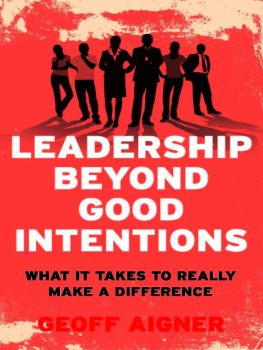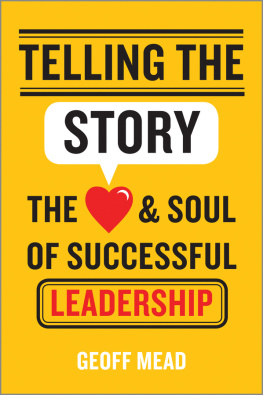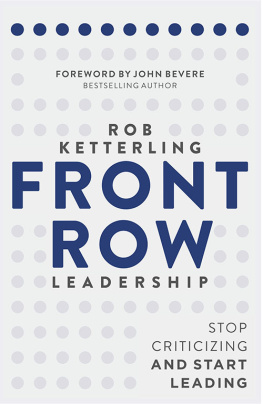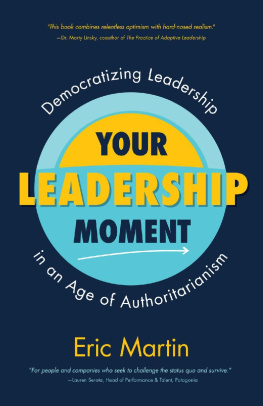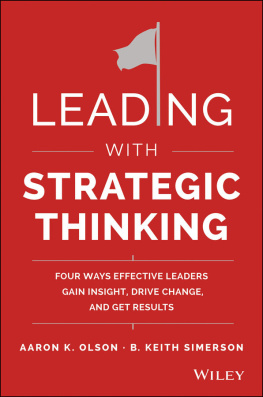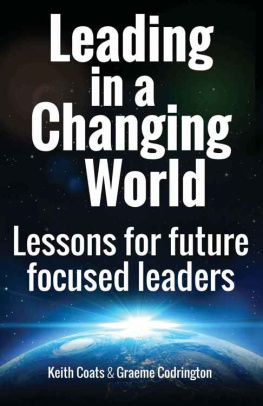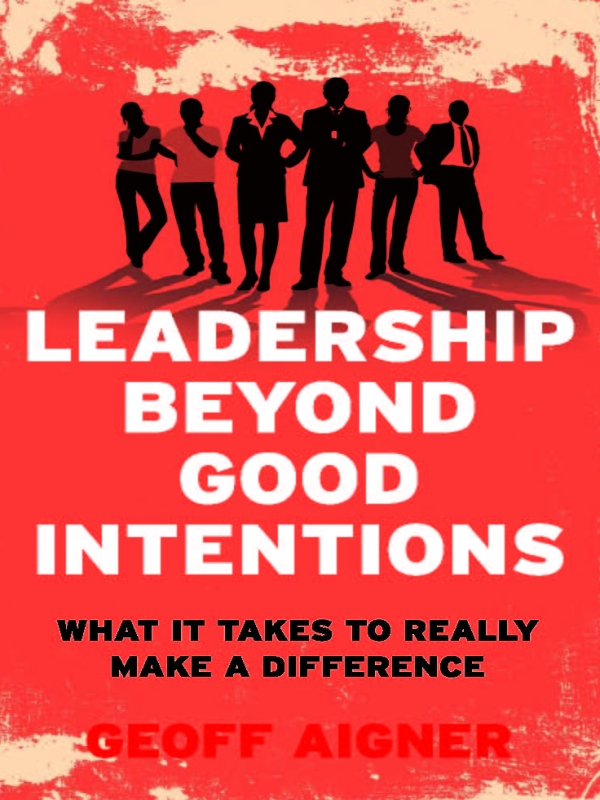
LEADERSHIP
BEYOND GOOD
INTENTIONS
What it takes to really make
a difference
GEOFF AIGNER

First published in Australia in 2011
Copyright Geoff Aigner 2011
All rights reserved. No part of this book may be reproduced or transmitted in any form or by any means, electronic or mechanical, including photocopying, recording or by any information storage and retrieval system, without prior permission in writing from the publisher. The Australian Copyright Act 1968 (the Act) allows a maximum of one chapter or 10 per cent of this book, whichever is the greater, to be photocopied by any educational institution for its educational purposes provided that the educational institution (or body that administers it) has given a remuneration notice to Copyright Agency Limited (CAL) under the Act.
Allen & Unwin
83 Alexander Street
Crows Nest NSW 2065
Australia
Phone: (61 2) 8425 0100
Fax: (61 2) 9906 2218
Email: info@allenandunwin.com
Web: www.allenandunwin.com
Cataloguing-in-Publication details are available from the
National Library of Australia
www.trove.nla.gov.au
978 1 74237 394 2
Typeset in 11/15 Minion by Midland Typesetters, Australia
Printed and bound in Australia by McPhersons Printing Group
10 9 8 7 6 5 4 3 2 1

To May
Contents
by Lama Ole Nydahl
Part 1 Understanding the system
the context of change
Part 2 Understanding ourselvesthe inner work
of leadership
An often underestimated richness in life today and in realms of science is the vast amount of information that may be immediately accessed and combined, adding ever new dimensions to beings search for meaning and happiness and to those who wish to avoid getting stuck in unproductive and often boring loops of activity.
Building on many years of experience, and with a keen sense of social responsibility, my friend Geoff shares his suggestions on a caring society for leaders from business, government, and the social and private sectors.
Comparing and combining the solutions and experiences given over thousands of years by humanistic cultures and religions with the latest of todays practical and statistical knowledge, I see a powerful and convincing force for good appearing with this book. May it benefit many.
Lama Ole Nydahl
The stories and people discussed in this book are real. I would like to thank those who have shared their experiences and ideas with me. These include Tania Adams, Jeff Cheverton, Jennifer Cullen, Kyrstie Dunn, Dominic Grenot, Sheila Matete-Owiti, Richard Matthews, Liz Skelton, Jude Stoddart, Nicole Yade and Mark Yettica-Paulson.
I would also like to thank the people who read all or parts of the manuscript and gave me very useful feedback, which not only helped the book but also my growth in the process: my wife May, who was both patient, caring and challenging; my colleagues and friends at Social Leadership Australia, Liz Skelton and Robbie Macpherson, provided invaluable encouragement and insight. Rosamund Christie and Adam Kahane generously offered their time and feedback in reading the manuscript.
There are others who have taught, helped or encouraged along the way. Foremost is Ole Nydahl. Also, Sarah Maddison, Maike Brill, Rob Sok and Katrina Hosie.
The consulting and leadership development work of Social Leadership Australia (SLA) has provided the basis for many of the ideas in this book. SLA is a part of The Benevolent Society, Australias oldest charity, established in 1813 as an independent, not-for-profit, non-religious organisation. SLA was established in 1999 to generate lasting positive social impact by creating a network of civic leaders from all sectors: corporate, government and community. I would like to acknowledge The Benevolent Society and its support in allowing this book to come to life.
GOOD INTENTIONS ARE NOT ENOUGH
It is often surprising for people who want to make positive change in their organisations or communities to find themselves facing much resistance and many obstacles. These difficulties are not unique to any particular sector, community, profession or culture. It is not uncommon for:
managers in corporations fighting for the sustainability of their business to themselves get scape-goated;
social workers dealing with marginalised communities to feel they have run out of compassion;
social activists with an important message to get sidelined, ridiculed or not even heard;
spiritual leaders charged with the development of their congregations to get stymied by the conflicting expectations they face;
public servants shouldered with our most difficult problems to become cynical and lose hope.
The temptation is to look outside ourselves to answer these problems, to look to new tools, frameworks or models. We see problems in our environment. We may find that the individuals or institutions we are working with are wilfully or ignorantly blocking change. The timing might be wrong. These are all important factors, but we may not be looking at one of the most important parts of the challenges we face: ourselves. It can be hard for us to admit that we might be part of the problem we are trying to fix. It is usually easier to give up, than to see our own role in the mess. After all, we often put our heart and soul into what we are doing. Moreover, we may receive (at least when we start) many positive affirmations from friends and colleagues on how important our work is and why we need to keep doing it.
This book looks at why, despite there being so many skilled, willing and dedicated change agents with good intentions, we still face intractable problems. Its focus is you. Let me explain by way of a story:
Its March 2008 and I am somewhere outside of Broome in north-west Australia in a 4WD bus with a group of 30 people. Outside, the brilliant red sand of the Kimberleys shimmers in the unforgiving midday sun. The heat is intense.
I left Sydney 18 hours ago excited to be part of the first Australian Dialogue, a process to begin a new conversation between black and white Australians. On the plane I spent most of the time diligently (and I admit anxiously) reading all the background material. On arrival into Broome, I shook hands eagerly with the other participants.
Now, 30 minutes later, I am sitting at the back of the bus with a group of people I already feel quite distant from, not knowing where we are going, not understanding why we are driving north instead of south (I read the map incorrectly!), feeling more and more nauseous as we hit big bumps at seemingly faster speeds. And inevitably I wonder what I am doing here and whether this really was such a good idea.
And then it struck me! This is what happens to so many of us. We start with good intentions and excitement and then find ourselves in the middle of nowhere, not knowing where we are going or why, and unsure about our company. And we generally have a set of fixed responseswe can take it out on our fellow travellers, look for a new bus, keep on travelling into the desert and oblivion, or turn around and go home.
I wanted to go home.
If we are honest with ourselves we know that the problem is not just the bus or our colleagues and the answer may be something other than turning around or continuing on. In a way the environment is irrelevant because sooner or later we are going to find ourselves in the same predicament again. And I know I will feel the urge to go home, like I did at that moment. I will also probably find all the usual (and very convincing) reasons to do exactly that.
Next page
